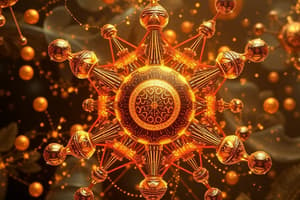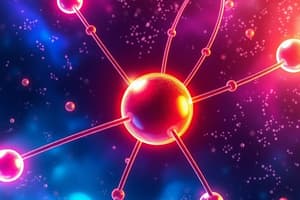Podcast
Questions and Answers
What would happen to the properties of an atom if it had more protons and fewer neutrons in the nucleus?
What would happen to the properties of an atom if it had more protons and fewer neutrons in the nucleus?
- The properties of the atom would change significantly (correct)
- The atom would become less stable
- The properties of the atom would remain unchanged
- The atom would become larger in size
What are the specific pairs of protons and neutrons called?
What are the specific pairs of protons and neutrons called?
- Neutrinos
- Nuclides (correct)
- Molecules
- Electrons
Where are electrons found in an atom?
Where are electrons found in an atom?
- Within the neutron particles
- In the proton shells
- In the electron clouds outside the nucleus (correct)
- Inside the nucleus
How many electrons can electron clouds hold?
How many electrons can electron clouds hold?
What did scientists discover in 2008 that was previously unknown?
What did scientists discover in 2008 that was previously unknown?
What impact did the discovery of neutrinos have on physicists?
What impact did the discovery of neutrinos have on physicists?
What is the charge of a neutron?
What is the charge of a neutron?
Where do electrons orbit in an atom?
Where do electrons orbit in an atom?
Which particle in an atom gives it most of its mass?
Which particle in an atom gives it most of its mass?
What do the number of electrons in an atom's shells determine?
What do the number of electrons in an atom's shells determine?
Which two important numbers are contained in an atom's nucleus?
Which two important numbers are contained in an atom's nucleus?
What does the atomic mass number of an atom indicate?
What does the atomic mass number of an atom indicate?
Flashcards are hidden until you start studying
Study Notes
Atomic Structure
Atoms form the building blocks of our world. They make up everything around us—from the air we breathe to the food we eat. To understand how atoms work together to create complex structures like molecules, it's essential first to grasp their fundamental composition and organization within the atom itself. Let's delve into the fascinating realm of atomic structure.
An atom is composed of three main types of particles. A proton has a positive charge (+1), while neutrons have no electric charge and a mass almost equal to that of a proton. Electrons orbit the nucleus in shells called energy levels with negative charges (-1). The number of electrons in these shells determines what element an atom belongs to.
The protons and neutrons reside in the center of the atom, known as its nucleus, which gives the atom most of its mass. This central core holds the atom's identity because it contains two important numbers: the atomic number and the atomic mass number.
The atomic number represents the type of atom; each chemical element has one particular number that refers only to it. It tells you the number of protons inside the nucleus. For example, hydrogen, the simplest atom, has just one proton in its nucleus, so its atomic number is 1. Helium, another simple atom, has two protons, making its atomic number 2.
On the other hand, the atomic mass number includes both protons and neutrons, providing an indication of how much the atom weighs compared to others. If an atom had more protons and fewer neutrons in the nucleus, such as having six protons instead of five, this would change the properties of the atom significantly. But since there are many stable combinations of protons and neutrons—these specific pairs are called nuclides—scientists can predict whether any given combination will survive without falling apart.
Electrons are tiny negatively charged particles found outside the nucleus. They move around it in different shells, also referred to as electron clouds, where they do not have set positions. These clouds can hold between zero and seven electrons. As electrons move through various shells, the total amount of energy remains constant, ensuring conservation of energy.
It wasn't until 2008 that scientists discovered the existence of a fourth kind of particle that was previously unknown. Called neutrinos, they are very lightweight neutral particles that pass right through matter unaffected by gravity or electromagnetic forces. It seems impossible for anything else to interact with them!. Neutrinos don't affect ordinary matter, but their discovery led physicists down new avenues of exploration.
Understanding atomic structure provides valuable insight into how atoms behave when bonding together to form molecules. We will explore those bonds next.
Studying That Suits You
Use AI to generate personalized quizzes and flashcards to suit your learning preferences.




